Bridge for Beginners:
A Complete Course
Zia Mahmood
with Audrey Grant
Foreword by Omar Sharif
To my brother Ali, to L.B.,
and to those we love who are no longer with us
First published in the United Kingdom as an eBook in 2014 by
Batsford
1 Gower Street
London WC1E 6HD
An imprint of Pavilion Books Company Ltd
www.batsford.com
Zia Mahmood 1994, 1998
The moral rights of the author have been asserted.
All rights reserved. No part of this publication may be reproduced, stored in a retrieval system, or transmitted in any form or by any means, electronic, mechanical, photocopying, recording or otherwise, without the prior written permission of the copyright owner.
eBook ISBN: 9781849942072
Foreword
I think it was just before filming Lawrence of Arabia that I first discovered that finesse didnt necessarily mean choosing the correct vintage of Dom Perignon. It was a discovery that changed my life, as this introduction to the game of bridge, which developed initially as a method of combating the frequent boredom of film making, changed to a passion and an involvement that are stronger today than ever. It would be difficult to count the hours of pleasure I have received from bridge, surely the most fascinating of games ever invented, and I hope that you too can derive the same joy after this introduction to the game.
Zia has long been a friend of mine and he is rated by many as the No 1 player in the world. In my opinion, however, his contribution has been much more than expertise because of the charisma and sense of fun that he brings with him to the game. He is the living proof that bridge is not a boring game for boring people but an exciting game that mixes all the most vital human qualities and emotions.
In Bridge for Beginners, Zia has combined his expertise and sense of humour with the talents of the internationally known teacher and author Audrey Grant to bring an introduction to the game that is essential for all beginners.
For once, you can learn the secrets of the game presented in a simple yet entertaining manner that is as much fun to read as to play. For once, you can actually listen to an expert as he talks you through his thoughts on every basic step and situation. Finally, once you have read this book, I hope you will take up the game of bridge as I once did, because I already know that its lure is irresistible once felt, its addiction heady and exciting, and I would to like share this knowledge.
Omar Sharif
PART ONE: BIDDING
CHAPTER 1
Introduction
It is generally accepted that contract bridge started in about 1925 when Harold Sterling Vanderbilt was cruising the Caribbean on the SS Finland. He picked up a pack of cards, shuffled them, and said Gentlemen, let me show you a new game. It may interest you.
Bridge is said to be the Rolls-Royce of card games, and for good reason. It can be as comfortable as your favourite pair of shoes, and yet at the same time it can excite you as much after you have played for years as when you first experienced the game. Bridge can be a quiet source of pleasure when you play in familiar surroundings with friends you have known all your life, or a tool which introduces you to new people in new places. Tennis star Martina Navratilova once said that bridge meant a lot to her in her travels: No matter where I go, she said, I can always make new friends at the bridge table. Omar Sharif is said to have given up acting, horses and women for the game. For others, bridge is a great social activity. It is difficult to believe that bridge is good for us; to believe that something that brings so much joy is neither immoral, against the law nor bad for our health. If you are not yet familiar with the game, what have you been waiting for? If you have played for years, its time to introduce you to some of the secrets of the experts, taught, we hope, with a mixture of fun and simplicity.
Getting started
All you need are three other people and a pack of cards. If you have a card table, four chairs and a pencil and paper to keep score, so much the better. Already you are as well-equipped as a world champion!
Bridge is a partnership game. Although you can play with a regular partner, it is common to cut for partners. To do this, take the cards and spread them face down on the table. Each player selects a card and turns it up. The cards are ranked as usual in this order: Ace (highest), King, Queen, Jack, 10, 9, 8, 7, 6, 5, 4, 3, 2 (lowest). The players choosing the two higher-ranking cards play together and those picking the two lower-ranking cards are partners. If the four cards turned over were an ace, a king, a jack and a 3, the players choosing the ace and king would play together and the players turning over the jack and 3 would be partners.
What if two players pick the same ranked card? Lets consider a most unusual case where all four players pick aces. It looks as if there is a four-way tie, but there is a method of breaking such a tie. The suits are ranked in alphabetical order with the clubs ( ) being the lowest ranked suit, then diamonds (
) being the lowest ranked suit, then diamonds ( ), hearts (
), hearts ( ) and, at the top, the highest ranking suit, spades (
) and, at the top, the highest ranking suit, spades ( ). In the situation mentioned above, then, the players with the ace of spades (
). In the situation mentioned above, then, the players with the ace of spades ( A) and ace of hearts (
A) and ace of hearts ( A) would play against the players holding the ace of diamonds (
A) would play against the players holding the ace of diamonds ( A) and ace of clubs (
A) and ace of clubs ( A).
A).
The partners sit opposite one another. Bridge writers refer to the players not by name but by direction: North, East, South and West. Here, then, are the four players sitting round the table:

Introducing the play
Once everyone is sitting down and ready to play, the player who chose the highest card deals. The jokers are not used, so a bridge pack consists of 52 cards. Starting with the player on his left, the dealer deals one card at a time to each player, proceeding clockwise around the table, until the pack is exhausted and each player has 13 cards. If, during the deal, a card is accidentally turned face up, the deal must be restarted the pack must be shuffled and cut, and the dealer tries again! Each player picks up his hand and sorts it into suits. It is easier to see your hand if you separate the black and red suits. Here is a sorted bridge hand:

In a book or newspaper, the above bridge hand is usually written out in the ranking order of the suits, with spades first, then hearts, diamonds and clubs as follows:

The objective during the play of the hand is for your partnership to try to take as many tricks as you can. A trick consists of four cards, one from each player, and the player contributing the highest card wins the trick for his side. The player who wins each trick
Next page
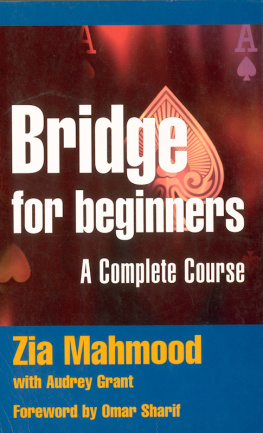

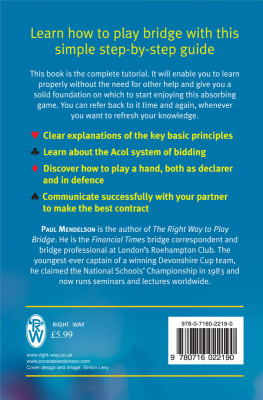
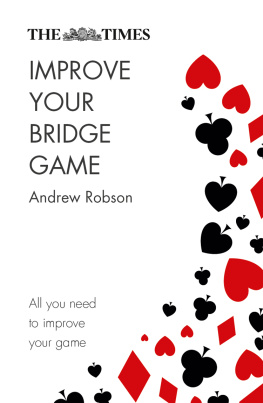

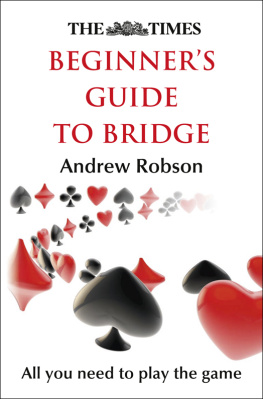
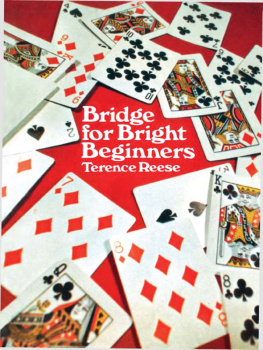

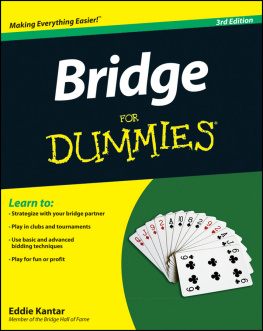
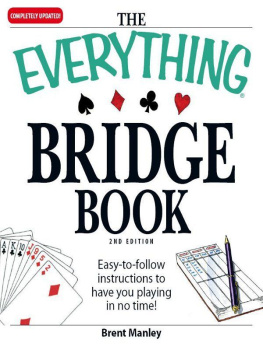
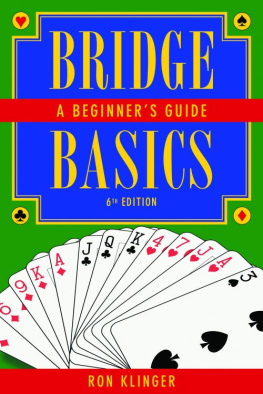
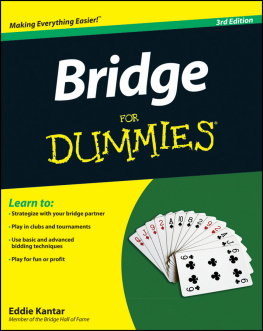
 ) being the lowest ranked suit, then diamonds (
) being the lowest ranked suit, then diamonds ( ), hearts (
), hearts ( ) and, at the top, the highest ranking suit, spades (
) and, at the top, the highest ranking suit, spades ( ). In the situation mentioned above, then, the players with the ace of spades (
). In the situation mentioned above, then, the players with the ace of spades (

